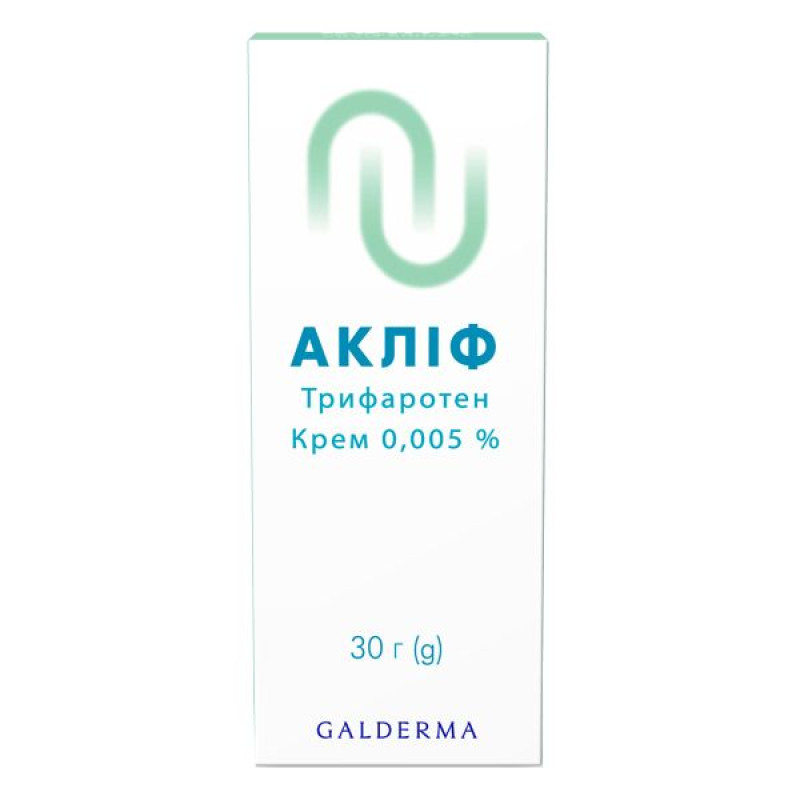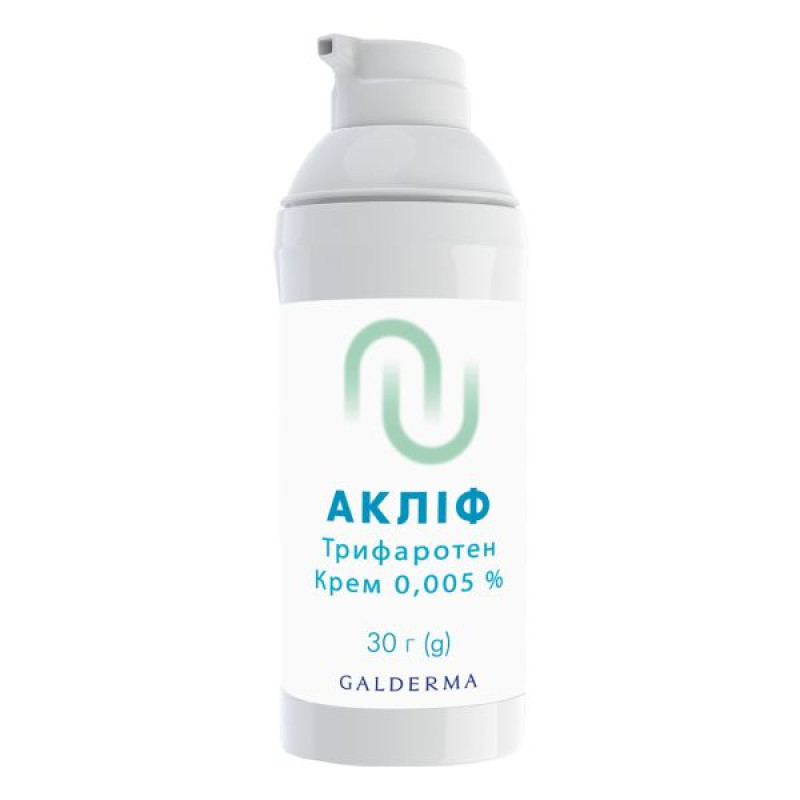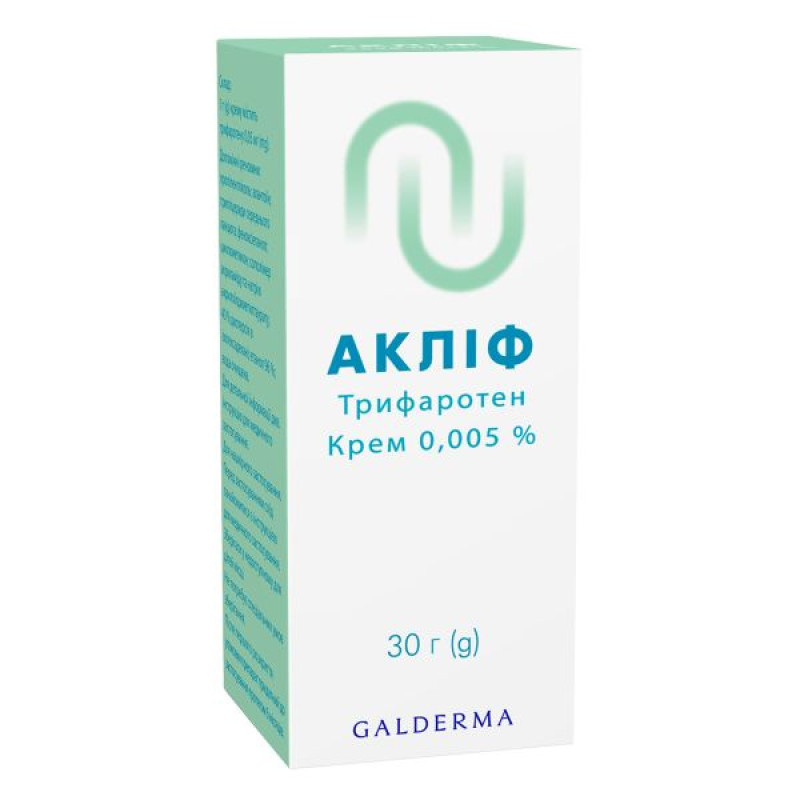Aclif cream 0.005% container 30 g

Instructions for use: Aclif cream 0.005%, container 30 g
Composition
active ingredient: trifarotene;
1 g of cream contains 0.05 mg of trifarotene;
excipients: propylene glycol; allantoin; medium chain triglycerides; phenoxyethanol; cyclomethicone; copolymer of acrylamide and sodium acryloyldimethyltaurate, 40% dispersion in isohexadecane; ethanol 96%; purified water.
Dosage form
Cream.
Main physicochemical properties: white and homogeneous preparation.
Pharmacotherapeutic group
Preparations for the topical treatment of acne. Retinoids for the topical treatment of acne. Trifaroten. ATX code D10A D06.
Pharmacological properties
Pharmacodynamics
Aclif cream contains 0.05 mg/g of trifarotene, which is a chemically stable terphenyl acid derivative with retinoid-like activity. It is a potent RARg agonist (retinoic acid receptor g agonist), characterized by its high specificity for this receptor compared to RARa and RARb (50- and 8-fold, respectively, without retinoid X receptor (RXR) activity).
In addition, trifarotene modulates retinoid target genes (differentiation and inflammatory processes) in immortalized keratinocytes and reconstructed epidermis.
Pharmacodynamic effects
In a mouse model with the Rhino mutation, trifarotene demonstrated significant comedolytic activity with a reduction in comedone count and a marked increase in epidermal thickness. In this model, the same comedolytic effect was obtained with approximately 10-fold lower doses of trifarotene than with other known retinoids.
Trifaroten also exhibited anti-inflammatory and depigmenting activity.
Pharmacokinetics
Absorption
Absorption of trifarotene was evaluated in adults and children (10–17 years) with acne vulgaris. Patients were treated for 30 days with 2 g of Aclif once daily applied to the face, shoulders, chest, and upper back.
Overall, systemic exposure levels were low and similar in adults and children.
After 4 weeks of treatment, seven of nineteen (37%) adult patients had quantifiable plasma levels of trifarotene. Cmax ranged from below the limit of quantification (LOQ 0-24 h - 75-104 pg. h/mL.
Three of seventeen (18%) pediatric patients had quantifiable systemic exposure. Cmax ranged from below the limit of quantification (LOQ 0-24 h - 89-106 pg. h/mL.
Steady state was achieved in both adults and children after 2 weeks of topical administration. No accumulation of the drug is expected with prolonged use.
Distribution
Trifarotene penetrates the skin exponentially (gradually and continuously increasing the concentration in the tissues) from the stratum corneum to the epidermis and dermis.
In vitro studies have shown that trifarotene is more than 99.9% bound to plasma proteins. No significant binding of trifarotene to erythrocytes was observed.
Biotransformation
In vitro studies using human liver microsomes and recombinant CYP450 enzymes have shown that trifarotene is primarily metabolized by CYP2C9, CYP3A4, CYP2C8 and to a lesser extent CYP2B6.
Potential for pharmacokinetic drug interactions
In vitro studies have demonstrated that Aclif cream, at concentrations achieved systemically after topical application, does not inhibit the CYP450 isoenzymes CYP1A2, 2B6, 2C8, 2C9, 2C19, 2D6, and 3A4 and does not induce CYP1A2, 2B6, or 3A4.
In vitro studies have demonstrated that Aclif cream, at concentrations achieved systemically after topical application, does not inhibit the uptake transporters MATE, OATP, OAT, or OCT, nor the efflux transporters BCRP, PgP, BSEP, or MPR.
Preclinical safety data.
Note: from animal studies, calculations of multiple systemic exposure factors for humans were based on a comparison of the area under the curve (AUC) for topical application of a 2 g dose of Aclif cream applied to humans once daily.
Non-clinical data reveal no special hazard for humans based on conventional studies of safety pharmacology, oral repeated dose toxicity, genotoxicity, or carcinogenic potential.
In repeated-dose dermal toxicity studies in minipigs up to 9 months of age, systemic exposure to trifarotene was very low, generally below the limit of quantification. There were no systemic effects and the only notable finding was reversible skin irritation at the application sites.
An oral study in rats showed that trifarotene and/or related metabolites penetrated into breast milk.
Indication
Aclif is indicated for the treatment of common acne (acne vulgaris) on the face and/or trunk in patients aged 12 years and older with multiple comedones, papules, and pustules.
Contraindication
Pregnancy.
· Pregnancy planning.
· Hypersensitivity to the active substances or to any of the excipients.
Interaction with other medicinal products and other types of interactions
The effect of Aclif cream on other medicines
Effect of other medicines on Aclif cream
Clinical drug interaction studies have not been conducted to evaluate the effects of other drugs on systemic levels of trifaroten (see section “Pharmacological properties”).
There is no data on the potential for pharmacodynamic interactions with trifaroten. Particular caution should be exercised when using cosmetics with a desquamative effect or those that irritate or dry the skin, as additional irritation may occur when used with the drug (see section "Special instructions").
Application features
Erythema, scaling, dryness and tingling/burning may occur with the use of Aclif cream (see section "Adverse reactions"). Patients should be instructed to use a moisturizer during treatment to reduce the risk of such reactions and, if necessary, reduce the frequency of application of Aclif cream or temporarily discontinue its use. If severe reactions to the use of the drug cannot be eliminated despite mitigating measures, treatment may be discontinued.
The product should not be applied to cuts, abrasions, eczematous areas, or sunburned skin.
As with other retinoids, waxing should be avoided on skin treated with Aclif.
In case of suspected hypersensitivity to any of the components of the drug, the use of Aclif cream should be discontinued. Particular caution should be exercised when using cosmetics with a desquamative effect or those that irritate or dry the skin, since additional irritation may occur when used with a medical product.
Avoid contact of Aclif with eyes, eyelids, lips or mucous membranes. If the drug gets into the eyes, rinse them immediately and thoroughly with warm water.
Excessive exposure to sunlight, including sunlamps and phototherapy devices, should be avoided during treatment. When exposure cannot be avoided, it is recommended to use a broad-spectrum, waterproof sunscreen with a sun protection factor (SPF) of 30 or higher and cover treated areas with clothing.
This medicine contains propylene glycol (E1520), which may cause skin irritation. The medicine also contains alcohol (ethanol) 50 mg/g, which may cause a burning sensation on damaged skin.
Use during pregnancy or breastfeeding
Oral retinoids have been associated with birth defects. When used topically as directed, retinoids generally have low systemic exposure due to minimal absorption through the skin. However, individual factors (e.g., skin barrier damage, overuse) may contribute to increased systemic exposure.
Pregnancy
The drug Aclif is contraindicated for use (see the "Contraindications" section) in pregnant women or women planning a pregnancy.
Animal studies of trifarotene have demonstrated reproductive toxicity at high oral doses.
If the drug is used during pregnancy or if the patient becomes pregnant while using this drug, treatment must be discontinued.
Breast-feeding
It is not known whether trifarotene or its metabolites pass into breast milk.
Available data from pharmacological/toxicological studies in animals have shown excretion of trifarotene/metabolites in breast milk.
A risk to the breast-fed child cannot be excluded. Therefore, a decision must be made whether to discontinue breast-feeding or to discontinue/abstain from Aclif therapy taking into account the benefit of breast-feeding for the child and the benefit of therapy for the woman.
To avoid the risk of ingestion by the infant and/or contact exposure to the infant, nursing women should not apply trifaroten cream to the breasts or chest area.
Fertility
No studies have been conducted on the effects of Aclif on reproductive function.
In oral reproductive studies in rats, trifarotene had no effect on fertility. However, signs of germ cell degeneration were observed in dogs after oral administration.
Ability to influence reaction speed when driving vehicles or other mechanisms
The drug Aklif does not affect or has a negligible effect on the reaction speed when driving vehicles or working with other mechanisms.
Method of administration and doses
Dosage
Apply a thin layer of Aclif cream to the affected areas of the face and/or body once a day, in the evening, on clean and dry skin.
It is recommended to consult a doctor to assess the patient's continued improvement after three months of treatment.
Certain patient groups
Elderly patients
The safety and effectiveness of Aclif in geriatric patients over 65 years of age have not been established.
Renal and hepatic failure
Studies of the drug Aclif in patients with impaired renal and hepatic function have not been conducted.
Method of administration and doses
Apply a thin layer of Aclif cream to the affected areas of the face (forehead, nose, chin, right and left cheeks) and torso once a day, in the evening, on clean and dry skin.
For ease of use, the container containing the drug Aclif is equipped with a pump. Before first use, it must be filled by pressing it several times until a small amount of the drug is released (maximum 10 times). The pump is now ready for use:
- One pump should be enough to apply to the face (i.e. forehead, cheeks, nose and chin).
- Two pumps should be sufficient for application to the upper torso (i.e. accessible upper back, shoulders and chest). One additional pump can be used to apply the cream to the mid and lower back if acne is present.
Patients should be instructed to avoid contact with the eyes, eyelids, lips and mucous membranes and to wash their hands after applying the medicinal product.
If necessary, it is recommended to use a moisturizer while using Aclif. It is necessary to allow sufficient time for the skin to be dry before and after using Aclif.
Children.
The safety and effectiveness of Aclif in children under 12 years of age have not been established.
Overdose
Aclif is intended for once-daily topical use only.
Overuse of the product will not provide faster or better results and may result in noticeable redness, peeling, or discomfort on the skin. In this case, you should stop using the product and wait until the skin recovers.
In case of accidental ingestion, appropriate symptomatic measures should be taken. Continuous ingestion of the drug may cause the same side effects as excessive oral use of vitamin A.
Adverse reactions
Consolidated safety profile
Local skin reactions such as erythema, scaling, dryness and tingling/burning were reported among other adverse events as an indicator of local tolerability. These skin reactions on the face were very common and were mild, moderate and severe in 39%, 29.7% and 6.2% of patients, respectively. On the trunk, up to 32.9%, 18.9% and 5.2% of patients had mild, moderate and severe reactions, respectively. The maximum severity of local skin reactions on the face was usually observed in the 1st week of drug administration, and on the trunk - in the 2nd to 4th weeks and decreased with continued drug administration (see section "Special instructions").
The most commonly reported adverse reactions, as described in the table below, are application site irritation, pruritus, and application site sunburn, which occurred in 1.2-6.5% of patients treated with Aclif cream in clinical trials.
Summary of adverse reactions
Adverse reactions reported in 12-week placebo-controlled phase 3 studies in 1220 patients treated with Aclif cream (and for which the rate with Aclif cream exceeded the rate with placebo cream) are presented in the table.
Adverse reactions are classified by system organ class and frequency as follows: very common (≥ 1/10), common (≥ 1/100 to < 1/1000), uncommon
| Organ system class | Frequency | Adverse reactions |
| General disorders and administration site conditions | Often | Skin irritation at the application site Itching at the application site |
| Infrequently | Pain at the application site Dry skin at the application site Skin depigmentation at the application site Erosion at the application site Rash at the application site Swelling at the application site | |
| Rarely | Erythema at the application site Hives at the application site Vesicles at the application site | |
| Injuries, poisonings and procedural complications | Often | Sunburn |
| Skin and subcutaneous tissue disorders | Infrequently | Skin irritation Acne Allergic dermatitis Erythema |
| Rarely | Asteatotic eczema Seborrheic dermatitis Burning sensation of the skin Cracked skin Skin hyperpigmentation | |
| From the organs of vision | Rarely | Peeling eyelid skin Eyelid swelling |
| Gastrointestinal tract | Rarely | Haylit |
| From the vascular system | Rarely | Tides |
Reporting of suspected adverse reactions
Reporting of suspected adverse reactions during the post-marketing period of a medicinal product is important. This allows for continuous monitoring of the benefit/risk balance of the medicinal product. Healthcare professionals are required to report any suspected adverse reactions through the national reporting system.
Expiration date
2 years. After first opening the package, the drug is suitable for use for 6 months.
Storage conditions
Does not require any special storage conditions. Keep out of the reach of children.
Packaging
30 g of cream in a container; 1 container in a cardboard box.
Vacation category
According to the recipe.
Producer
HALDERMA LABORATORIES.
Location of the manufacturer and address of its place of business
ZI Mondesir 74540 ALBI-SUR-CHERAN, France.
There are no reviews for this product.
There are no reviews for this product, be the first to leave your review.
No questions about this product, be the first and ask your question.









